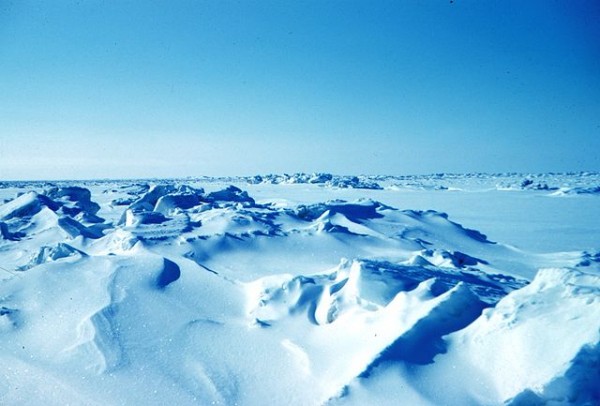Melting Arctic Permafrost to Gradually Release Greenhouse Gas
| Marco Foronda | | Apr 09, 2015 09:04 AM EDT |
(Photo : NOAA) Sea ice in the Beaufort Sea.
Recent research predicts a gradual release of greenhouse gases from permafrost soils in the Arctic and sub-Arctic regions, a finding that could give humans more time to adapt to these environmental changes.
Arctic permafrost is gradually melting because of global warming driven by human activities, resulting in the release of greenhouse gases into the atmosphere.
Like Us on Facebook
Permafrost soil is believed to contain about twice as much carbon than what currently exists in the Earth's atmosphere, according to research from the University of Alaska Fairbanks. As this soil thaws, it releases carbon dioxide and methane into the atmosphere, further accelerating global warming.
"In 2011, we assembled an international team of scientists into the Permafrost Carbon Network to synthesize existing research and answer the questions of how much permafrost carbon is out there, how vulnerable to decomposition it is once it's thawed, and what are the forms in which it's released into the atmosphere," said co-author A. David McGuire, U.S. Geological Survey senior scientist and climate modeling expert with the Institute of Arctic Biology at the University of Alaska Fairbanks.
Researchers are studying the process to determine how quickly these substances are being released in a quest to predict how it might affect climate change.
Analysis of several previous studies suggests that Arctic regions will likely emit these trapped gases slowly, over the course of several decades. Some climatologists expressed concerns the process could take place over just a few years in a scenario known as a climate bomb.
Temperatures in the Arctic have increased twice as fast as the global average over the last three decades, said researchers. This rate of warming has worried some researchers concerned with a runaway greenhouse effect.
Researchers believe this type of work is extremely important in helping scientists set their priorities for climate modeling. In the future, the team plans to continue improving the system in hopes of gaining more insight into the fate of permafrost. This new examination brings to light the balance between human-driven and natural processes in the environment.
The findings appeared in the journal Nature.
TagsMelting Arctic Permafrost to Gradually Release Greenhouse Gas, Arctic region, Arctic, ice glaciers, Greenhouse Gas, Arctic Permafrost, global warming, Permafrost soil, Carbon
©2015 Chinatopix All rights reserved. Do not reproduce without permission
EDITOR'S PICKS
-

Did the Trump administration just announce plans for a trade war with ‘hostile’ China and Russia?
-

US Senate passes Taiwan travel bill slammed by China
-

As Yan Sihong’s family grieves, here are other Chinese students who went missing abroad. Some have never been found
-

Beijing blasts Western critics who ‘smear China’ with the term sharp power
-

China Envoy Seeks to Defuse Tensions With U.S. as a Trade War Brews
-

Singapore's Deputy PM Provides Bitcoin Vote of Confidence Amid China's Blanket Bans
-

China warns investors over risks in overseas virtual currency trading
-

Chinese government most trustworthy: survey
-

Kashima Antlers On Course For Back-To-Back Titles
MOST POPULAR
LATEST NEWS
Zhou Yongkang: China's Former Security Chief Sentenced to Life in Prison

China's former Chief of the Ministry of Public Security, Zhou Yongkang, has been given a life sentence after he was found guilty of abusing his office, bribery and deliberately ... Full Article
TRENDING STORY

China Pork Prices Expected to Stabilize As The Supplies Recover

Elephone P9000 Smartphone is now on Sale on Amazon India

There's a Big Chance Cliffhangers Won't Still Be Resolved When Grey's Anatomy Season 13 Returns

Supreme Court Ruled on Samsung vs Apple Dispute for Patent Infringement

Microsoft Surface Pro 5 Rumors and Release Date: What is the Latest?










